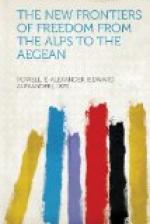[Illustration: THIS IS NOT VENICE, AS YOU MIGHT SUPPOSE, BUT TRIESTE
The sails of the fishing craft are of many colors, yellow, burnt-orange, vermilion. At the head of the canal, its stately columns reflected in the turquoise waters, the Bourse rises like some ancient Roman temple]
Trieste, which, with its suburbs, has a population of not far from 400,000, with its splendid terminal facilities, its vast harbor-works, its dry-docks and foundries, its railway communications with the hinterland, and, above all else, its position as the natural outlet for the trade of Austria, Bavaria and Czecho-Slovakia, constitutes not only Italy’s most valuable prize of war, but, everything considered, probably the most important city, commercially at least, to change hands as a result of the conflict. Curiously enough, Trieste is the least interesting city of its size, from a visitor’s point of view, that I know. Venice always reminds me of a beautiful and charmingly gowned woman, perpetually young, interested in art, in music, in literature, always ready for a stroll, a dance or a flirtation. Trieste, on the contrary, is a busy, preoccupied, rather brusque business man, wholly self-made, who has never devoted much time to devote to pleasure because he has been too busy making his fortune. Venice says, “If you want a good time, let me show you how to spend your money.” But Trieste growls, “If you want to get rich, let me show you how to invest your money.” The city has broad and well-kept streets bordered by the same sort of four-and five-and six-story buildings of brick and stone which you find in any European commercial city; it has several unusually spacious piazzas on which front some really pretentious buildings; it has a few arches and doorways dating from the Roman period, though far better ones can be found in almost any town on the Italian peninsula; on the hill commanding the city there are an old Austrian fort and an ancient church, both chiefly interesting for the views they command of the harbor and the coast of Istria; some of the most abominably rough pavements which I have ever encountered in any city; one hotel which just escapes being excellent and several which do not escape being bad; and a harbor, together with the wharves and moles and machinery which go with it, which is the Triestino’s pride and joy.
To my way of thinking the most interesting sight in Trieste is a small chateau, built in the castellated fashion which had a considerable vogue in America shortly after the close of the Civil War, which stands amid most beautiful gardens on the edge of the sea, two or three miles to the west of the city. This is the Chateau of Miramar, formerly the residence of the young Austrian Archduke Maximilian, who, dazzled by the dream of life on an imperial throne, accepted an invitation to become Emperor of Mexico and a few years later fell before a Mexican firing-party on the slopes of Queretaro. Though the chateau has now




